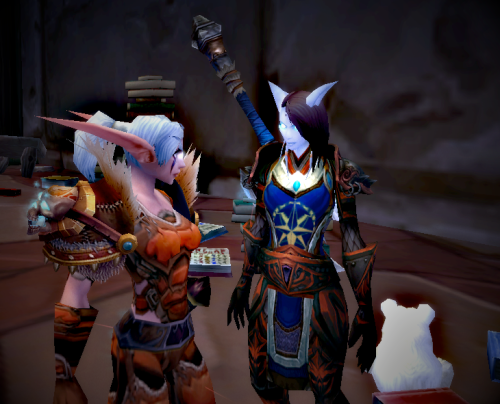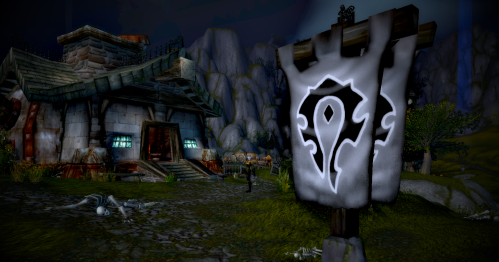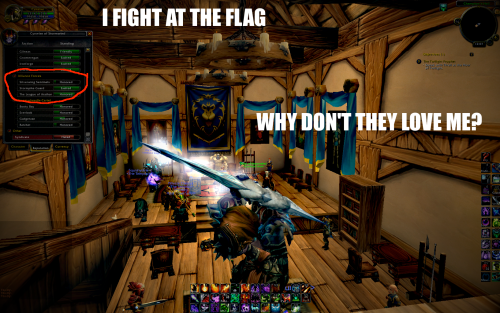
My druid, Cynli (born on Durotan), visits Visper, the GM of Waypoint on Medivh.
Play with your friends. That’s the promise that online games have held out to us for many years, the ability to play computer games with friends regardless of physical location. MMOs take this to an extreme – play with thousands of people, some of whom may be your friends – but that’s the general idea with any networked video game. It’s the reason that Blizzard implemented RealID messaging across their game platforms. It’s the reason why they are working towards removing your server as an impediment to playing with friends with cross-realm dungeons, raiding, battlegrounds. I fully expect to see cross-realm arenas, questing, and progression raiding in the future.
Blizzard has even started working on addressing one of the biggest problems with RealID – the lack of anonymity – by implementing a BattleTag system, one that will hopefully address the very real privacy concerns of RealID, while allowing people to still play with online friends. This is great! Over the past few years we, as a culture, have developed a lot of social network tools that allow us to control the amount of information we share online. This should be as true for a video game social network tool as it is for any other social tool; users care about how much information they present about themselves, and will migrate to tools which allow them the right amount of control.
Consider how different the internet landscape is today, in 2012, as opposed to 2004, when World of Warcraft launched. Facebook had launched a few months earlier, but in that year it expanded to over 800 colleges and grew to 1 million active users. Warcraft reached 10 million users in January 2008, while Facebook had reached 60-70 million. Social networks were in their infancy in 2004, centered around weblogs and photo sharing sites. The rise of Facebook is illustrative of a larger trend of making social internet tools more accessible, to a broader swath of the population.
I mean, the numbers are mind-boggling.
- One in nine people on the planet is on Facebook. (I’m not one of them.)
- Twitter handles a billion tweets every week.
- Google+ gained its first 10 million users in 16 days.
The amount of traffic generated by these kinds of sites is simply staggering. The impact of them upon MMOs like World of Warcraft cannot be understated. MMORPGs distinguish themselves from other video games by their social component, and since 2009 they are competing not just against other MMOs, but against all types of social computer activities – games, photo sharing sites, networking sites –
— even Farmville.
Furthermore, social networks have capitalized on something that MMOs have failed to – new mobile computing platforms. Only now, 5 years later, are we really able to see the impact that the iPhone’s introduction in 2007 had to the mobile computing market. It wasn’t just that it revolutionized the smartphone market – it did, making other manufacturers and platform developers realize they needed better interfaces and support for widespread application development. It also laid the groundwork for entirely new device markets like tablets, devices with great entertainment capability due to their flexibility, power, and ease of use. The iPad and Android tablet market has crushed other device types – remember when netbooks were going to be the new big thing? – and as technology moved away from the desktop, social media came right along with it.
Online social groups just aren’t what they were in 2004-05. We’ve rapidly moved past the idea of localized communities, instead going for fully global networks, with integration across websites and media. Your phone is, in all likelihood, a powerful computing device which can keep you connected to nearly all of these networks. It’s more likely that you keep in touch with your friends and family through some kind of social network than not.
And because it’s not just a social network, it’s also a video game, Warcraft is trying to keep up with these changes. Xbox Live is also doing this on the console space, but only WoW has both the subscriber base and the vision to pull off this necessary transformation.
I said in my post On Snow Crash, Virtual Avatars, and Warcraft’s Social Network Appeal that Warcraft is a video game bolted on top of a social network. I really think that gets to the heart of the matter, and is something that any criticism of Cataclysm needs to take into consideration. Not only does the video game have to be compelling, but it has to allow us to do things with our friends – friends who we are tied to through those other social networks. The sheer number of online connections people have now means that any networked video game needs to be able to be flexible enough to accommodate them, to allow them to play video games with those friends. Cloud-based gaming is the way of the future.
Battle.net is in a great position to become the default social network for computer RPGs. By providing a framework of interaction between players on different servers and even in different games, Blizzard can use Battle.net to allow other game companies to adopt their network instead of developing one themselves. By publishing APIs to be usable by third parties, this puts Blizzard in the position to:
- Capture the customer relationship (by requiring a free bnet account, or creating one for the player)
- Introduce players of other games to Blizzard products (free marketing)
- Create new revenue streams from other game companies for “enhanced” bnet services.
Is there a cost to this? Yes, absolutely, and as a product developer I’d be very concerned with how to recoup the operational and development costs here. Perhaps the API is free to use for most games, but special features (guild circles, intergame profile management, etc.) are charged to the hosting game company. Perhaps the Google+/Facebook model of monetizing member data is used. Maybe it’s a hybrid.
This kind of technology addresses a need that multi-player games will need in this new social reality, but game developers don’t want to spend time developing. It also has reach far beyond a single game – if it can get into the market with the right services, for the right price, with one of the largest embeddded userbases in the space, the potential for Blizzard to form an ubiquitous social gaming platform is very, very high.
However, there’s one problem within Warcraft that stands in the way: Guilds.
Do you have to belong to a guild in WoW, or not? Is it an optional social circle or a requirement for full participation in the game?
The guild system that has evolved in Cataclysm is very different from that which existed before, and is actively countering not only the general movement in social networks to be more inclusive, but also Blizzard’s own attempts to make players more able to play with their friends.
World of Warcraft’s infrastructure requires players to create accounts on specific, mutually exclusive servers. If I roll on Durotan, I cannot interact with players on Drenden or Moonrunner, and vice versa. Each server is effectively its own independent social network, limited in scope, much like old-school BBSes were. This made sense in 2004, but in 2012 social networks are broader, which is the whole point behind Real ID/BattleTags grouping. Warcraft is moving players towards a cloud-based existence, where your server matters less than your friends list. I personally think this is a good thing, because no matter how nostalgic I am for the old days of BBSes, I enjoy the present day reality of a global social network.
But guilds remain tied to servers, and they remain mutually exclusive.
This wouldn’t be quite as problematic if guilds were merely social units, like they were before Cataclysm. But not only do we now have to contend with the integrating this social circle in to the cloud-based experience, an entire system has been developed around them to make belonging to a guild valuable and worthwhile to a player.
Let’s take a simple example, a player who wants to play both Horde and Alliance. She joins nice guilds on both sides of the same server and enjoys spending time with each group. But depending on which character she chooses to play, she either has to choose one social group or the other. This doesn’t have anything to do with guild perks or reputation – imagine a social network that forced you to choose between talking to one set of friends or another when logging in, and see how popular that would become. It’s not enough to be able to talk individually. The community of a guild is important.
Now, while you might want controls over who you interact with at any time – think of Google+’s Circles here – you don’t even have that option here within Warcraft. Either you’re able to chat with Guild A, or with Guild B, but not both at the same time.
Yet, you’re able to talk to individuals in those guilds if they’re bnet friends.
Guilds, as they stand today, are both WoW’s greatest social strength and its strongest force working against letting players playing with their friends. Guilds are important, but they tie players to a specific group on a specific server, isolating and separating them.
But with a few changes, guilds can join the new cloud-based paradigm Blizzard is moving towards with Battle.net.
1. Allow player characters to belong to multiple guilds at the same time. How this manifests is open to debate – one guild might be chosen as the only one they can represent at a time, allow access to the bank, has the guild tag on display, generates guild rep towards that guild, etc.. At a minimum, give players access to the social components of guild membership – guild chat. This allows them to stay connected with their circles.
2. Allow guilds to function cross-server. Remove the server as a consideration of guild membership. Guilds need to be able to function as social units across servers. Are there technical restrictions to this? You bet. Perhaps guild banks and perks are limited to the founding server. Perhaps limits are put in place to how many cross-server members are allowed. But allow members to group up with other guild members easily, regardless of location.
3. Extend guild chat to games outside of Warcraft. This gets a little trickier, and may involve changing the guild association from character to player. Any Battle.net-enabled game should be able to carry with it the idea that a player is a member of a specific guild, and feed guild chat to him or her in that game’s chat interface. The game in question may not have guilds, but the player can still interact with those text channels through the game’s interface.
Imagine how different things would be right now if players of other MMOs could still be present in your guild’s chat.
4. Extend guild chat outside of video games. Stop tying the game’s social experience to video games and leverage existing social networks. Go multi-modal with their tools. As a game company, you have to consider the ROI of putting Battle.net on every different platform out there. My recommendation – don’t even try. Use their tools to get off the desktop and onto the phones and tablets of your players.
See, guilds are – or should be – supersets of friends, acquaintances, and even co-workers. They’re folks united with a common purpose, a common goal, even if they might not know each other very well. It doesn’t matter if they are a hard-core raiding team, a PvP world defense squad, or a fledgling leveling guild – they’re a group of people working together. Doing things together. Playing together.
Attaching mechanics to guilds causes pressure on the social cohesion of the group to conform to those rules, to achieve goals that are (in many cases) counter to the goals which brought them together in the first place. This genie is out of the bottle, so to make the best of it Blizzard needs to bring guilds into the cloud.
Like it or not, servers as social units are not Warcraft’s future. Each and every new cross-realm development shows this trend. Unfortunately, the guild structure remains the strongest bond to the server mentality in WoW.
For guilds to survive – and they need to survive – they need to change to meet the new social networking reality WoW finds itself in today.






















